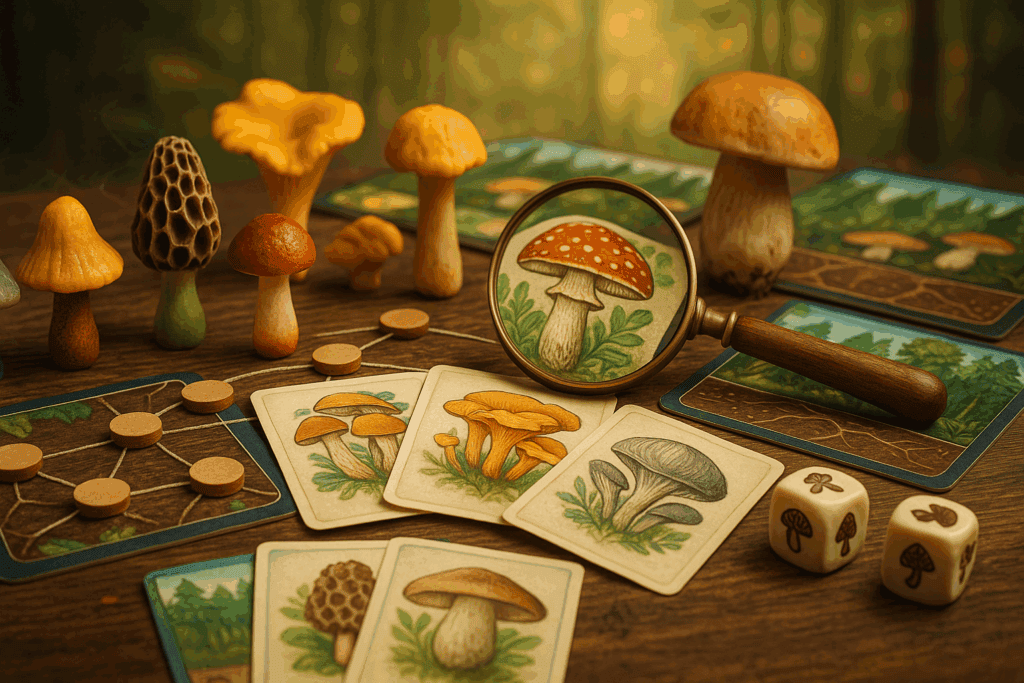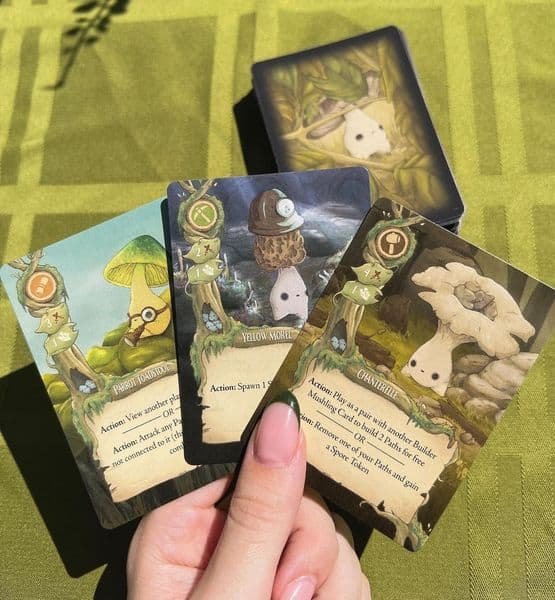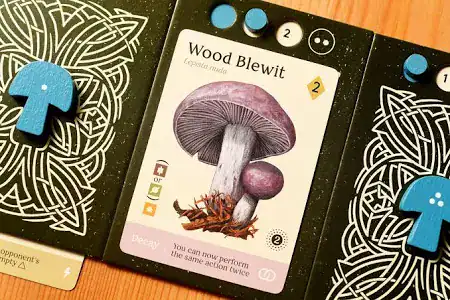
The fascinating world of mycology has found its way into the realm of tabletop gaming, creating a unique niche where science meets strategy. Mycology board games offer players the opportunity to explore the intricate world of fungi while engaging in compelling gameplay mechanics that mirror real-world fungal behaviors and ecological relationships.
Board games celebrating fungi have gained significant popularity among both mycology enthusiasts and casual gamers. These games successfully translate complex biological concepts into accessible, entertaining experiences that educate while they ente
rtain. The growing interest in mycology board games reflects our increasing awareness of fungi’s crucial role in ecosystems and their potential applications in biotechnology.
Morels: The Art of Mushroom Foraging
“Morels” stands as one of the most beloved mushroom collecting games in the tabletop community. This two-player card game captures the essence of foraging for these prized spring mushrooms in forest environments. Players must carefully manage their resources while competing for the best foraging spots.
Gameplay Mechanics and Mycological Accuracy
The game brilliantly simulates the seasonal nature of morel hunting, incorporating elements like:
- Habitat specificity: Different cards represent various forest environments where morels thrive
- Timing mechanics: Players must decide when to harvest versus when to wait for better opportunities
- Resource management: Balancing the collection of different mushroom types mirrors real foraging decisions
The mycological concepts in Morels extend beyond simple collection. The game includes cooking mechanics that reflect the culinary traditions surrounding these fungi, emphasizing the cultural significance of mushroom foraging.
Fungi: Comprehensive Mushroom Collection Strategy
“Fungi” (also marketed as “Mushroom Gatherer”) expands the scope beyond morels to include a diverse array of edible and medicinal mushrooms. This fungi board game creates a more comprehensive ecosystem where players must understand different species’ growing conditions and market values.
Educational Value in Gameplay
The game excels at teaching players about:
- Species identification: Different mushroom cards require players to learn visual distinctions
- Seasonal patterns: Various fungi appear at different times, reflecting natural growing cycles
- Medicinal properties: Special scoring for medicinal mushrooms highlights their therapeutic value
- Market dynamics: The economic aspect mirrors real-world mushroom markets
Mycelium: Building Underground Fungal Networks
“Mycelium” represents perhaps the most scientifically ambitious of the mycology board games, focusing on the underground networks that connect forest ecosystems. This game transforms the invisible world of fungal networks into a strategic territory-building experience.

Network Building Mechanics
Players in Mycelium must
- Establish connections: Building mycelial networks between trees and plants
- Resource sharing: Facilitating nutrient exchange between connected plants
- Network expansion: Strategic placement of network nodes for optimal coverage
- Symbiotic relationships: Managing beneficial partnerships with plant species
The game mechanics closely mirror the wood wide web phenomenon, where mycorrhizal networks facilitate communication and resource sharing between forest plants.
Read: Mycelium: A Mushling Game by YadCo Games — Kickstarter
Mycelia: Advanced Network Strategy
“Mycelia” takes the network-building concept even further than its predecessor, offering players a more complex and scientifically detailed approach to fungal network management. This advanced fungi board game focuses specifically on the intricate relationships between different mycelial species and their host organisms.

Deep Strategic Mechanics
Mycelia introduces several sophisticated gameplay elements:
- Species specialization: Different fungal species have unique abilities and partnership preferences
- Network efficiency: Players must optimize their mycelial networks for maximum nutrient flow
- Competitive inhibition: Some fungal species actively suppress competitors in their territory
- Seasonal cycles: Environmental changes affect network growth and resource availability
- Mutualistic scoring: Points awarded for successful long-term plant-fungi partnerships
READ: Mycelia Board Game Review
Under Grove: Subterranean Ecosystem Management
“Under Grove” explores the hidden world beneath the forest floor, where fungal networks form the backbone of underground ecosystems. This innovative fungi board game combines territory control with ecosystem management, challenging players to maintain the delicate balance of subterranean life.
Underground Ecosystem Dynamics
- Soil layer management: Players work across different soil depths, each with distinct properties
- Root-fungi interactions: Managing relationships between tree roots and mycorrhizal partners
- Decomposer networks: Breaking down organic matter to fuel ecosystem growth
- Water and nutrient cycling: Resource flows that mirror real underground processes
- Microorganism communities: Bacteria and other soil life that interact with fungal networks
Strategic Depth and Realism
The game excels at representing the complexity of soil ecosystems:
- pH balance mechanics: Different fungi thrive in various soil acidity levels
- Seasonal soil changes: Temperature and moisture variations affect gameplay
- Succession patterns: How underground communities develop over time
- Disturbance recovery: Responding to events like soil compaction or pollution
- Carbon sequestration: Long-term storage strategies that benefit all players
Under Grove stands out for its focus on the often-overlooked underground portion of forest ecosystems, making invisible processes tangible through engaging gameplay mechanics.
Mycological Concepts in Game Design
Spore Dispersal Mechanisms
Several mycelium network games incorporate spore dispersal as a core mechanic. These games typically feature:
- Wind patterns: Cards or dice that determine spore movement directions
- Distance mechanics: Limitations on how far spores can travel
- Survival rates: Not all dispersed spores successfully establish new colonies
- Environmental factors: Weather and terrain affecting dispersal success
Symbiotic Relationships
The representation of symbiotic relationships in fungal strategy games adds layers of strategic depth:
- Mycorrhizal partnerships: Games reward players for establishing beneficial plant-fungi relationships
- Competitive exclusion: Some species cannot coexist in the same territory
- Nutrient cycling: Decomposer fungi break down organic matter, providing resources for other players
Additional Mycology-Themed Board Games Worth Exploring
Photosynthesis: Forest Ecosystem Strategy
While not exclusively about fungi, “Photosynthesis” creates a comprehensive forest ecosystem where fungal decomposition plays a crucial role. Players manage tree growth cycles, and the game’s mechanics subtly incorporate how fungi contribute to nutrient cycling in forest environments.
READ: Photosynthesis Board Game to Cultivate Your Strategy Skills
Wingspan: Fungal Food Sources
“Wingspan” includes numerous bird cards that specifically mention fungal food sources. This award-winning game demonstrates how fungi support broader ecosystem food webs, making it an excellent complement to dedicated mycology board games.
READ: Games Like Wingspan: A Comprehensive List
Everdell: Woodland Creature Interactions
In “Everdell,” several cards represent fungi and their relationships with woodland creatures. The game showcases how different forest inhabitants, including fungi, interact within a thriving ecosystem.
READ: Everdell Board Game: A Comprehensive Review for Strategy Lovers
Ginkgopolis: Biotechnology and Fungi
“Ginkgopolis” explores sustainable city building with biotechnology themes, including fungal applications in urban environments. This game appeals to players interested in fungi’s role in future sustainable technologies.
Root: Woodland Warfare with Ecological Themes
“Root” features the Woodland Alliance faction, which represents the forest’s natural resistance to industrialization. While not explicitly about fungi, the game includes cards and mechanics that reference fungal networks and forest interconnectedness.
READ: Games Like Root
Arboretum: Tree and Fungi Relationships
“Arboretum” focuses on tree cultivation and includes several cards that highlight the symbiotic relationships between specific tree species and their fungal partners, making it educational for understanding mycorrhizal associations.
Branch & Claw (Spirit Island Expansion)
This expansion for “Spirit Island” introduces fungal-themed spirits and powers, representing how fungi can both nurture and devastate ecosystems depending on environmental conditions.
Flourish: Garden Ecosystem Building
“Flourish” incorporates soil health mechanics where fungal decomposers play essential roles in garden productivity. Players must balance various ecosystem components, including beneficial fungi.
Read: April Showers Bring Spring Board Games
The Community Aspect
Building Mycological Interest
These fungi board games have created communities of players who:
- Share real foraging experiences: Connecting game experiences with nature
- Organize themed events: Mushroom walks followed by game sessions
- Support conservation: Many games promote environmental awareness
- Foster learning: Players often pursue deeper mycological knowledge
Conclusion: The Growing Impact of Mycology Board Games
Mycology board games represent a unique intersection of science education and entertainment. Through engaging mechanics that mirror natural processes, these games make the hidden world of fungi accessible to players of all ages. Whether collecting morels in a competitive card game or building vast mycelial networks in strategic territory games, players gain appreciation for the complexity and beauty of fungal ecosystems.
The success of mushroom collecting games and mycelium network games demonstrates the appetite for scientifically grounded gaming experiences. As our understanding of fungi continues to expand, we can expect even more innovative games that celebrate these remarkable organisms and their essential role in maintaining healthy ecosystems.
For anyone interested in exploring the fascinating world where mycology meets gaming, these titles offer the perfect starting point for a journey into the underground networks that connect our forests and the incredible organisms that make it all possible.
READ: Top 10 Nature and Animal-Themed Board Games for Every Game Night
Frequently Asked Questions About Mycology Board Games
Q: What are the best mycology board games for beginners?
A: Morels is widely considered the best entry point for newcomers to mycology board games. Its simple two-player mechanics and beautiful artwork make it accessible while teaching basic foraging concepts. Photosynthesis also works well for beginners, as it incorporates fungal concepts within a broader forest ecosystem theme that’s easier to grasp than specialized mycological mechanics.
Q: Are mycology board games educational or just entertainment?
A: Mycology board games successfully combine education with entertainment. Games like Fungi and Mycelium incorporate scientifically accurate information about species identification, growing conditions, and ecological relationships. Many educators use these games in classroom settings because they make complex biological concepts tangible and memorable through hands-on gameplay.
Q: Can children play mycology board games safely?
A: Most mycology board games are designed with safety in mind and include clear warnings about real-world foraging. Games like Morels explicitly state that players should never eat wild mushrooms without expert identification. These games actually promote mushroom safety by teaching players about the complexity of species identification and the importance of caution when foraging.
Q: How scientifically accurate are the fungal concepts in these games?
A: Modern mycology board games strive for high scientific accuracy, with many designers consulting professional mycologists during development. Mycelium accurately represents network formation and nutrient sharing, while Fungi includes realistic seasonal patterns and habitat requirements. However, games do simplify complex ecological processes for playability while maintaining educational value.
Q: Where can I find mycology board games and what’s the typical price range?
A: Most mycology board games are available through specialty board game retailers, online marketplaces, and some hobby stores. Prices typically range from $25-60 USD: Morels ($25-35), Fungi ($40-50), and Mycelium ($45-60). Many games are also available as print-and-play versions or through digital platforms for budget-conscious players interested in exploring fungal strategy games.



